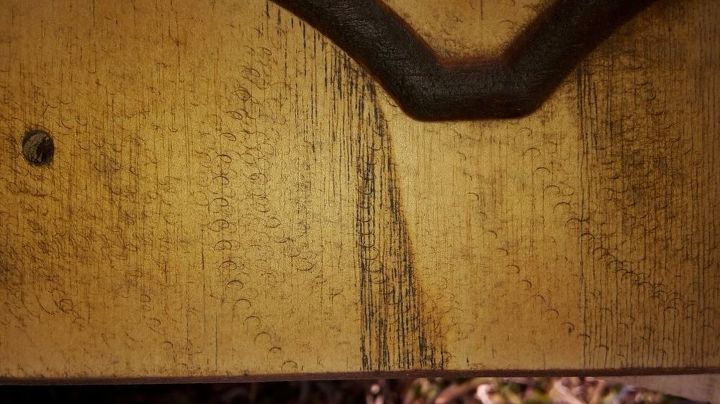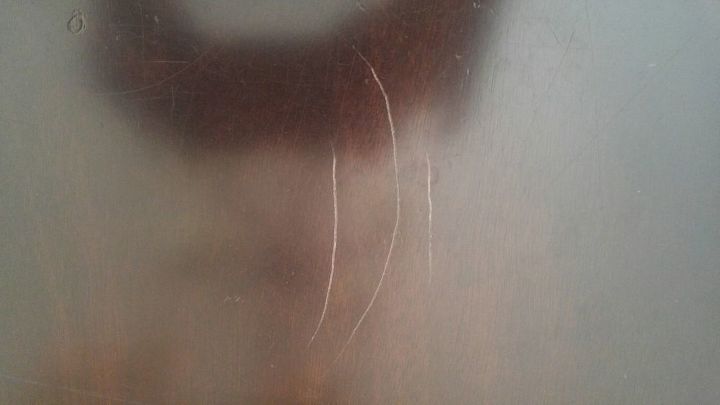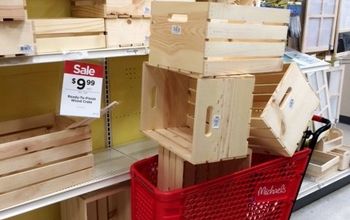Sanding wood question
-
Its caused from the incorrect grit. You have to go up gradually. for instance, start with an 80, then 120, 150, and finally 220. If you use a 60 and then jump to a 220, you will get those. Be careful with your pressure on the sander. Let it do the work for you. I like using a sanding block to finish up sometimes. That way you can avoid those. It also looks like you may have some existing finish on the wood. You can try a stipper to get rid of that. But to loose those swirls, you will have to start with a rough grit and work your way up.
 Beth H. Makemeprettyagain.blogspot
on Feb 12, 2016
Helpful Reply
Beth H. Makemeprettyagain.blogspot
on Feb 12, 2016
Helpful Reply -
-
Beth has given you the best answer .
 Jean Myles
on Feb 12, 2016
Helpful Reply
Jean Myles
on Feb 12, 2016
Helpful Reply -
-
This can happen with any grit that is used. It occurs when a particle comes loose from the sandpaper and gets trapped under the sandpaper. Graduating from one grit to another does minimize the possibility of it occurring but again, it can still occur. Less pressure will also minimize the possibility. If you are staining, you can dip the final grit of sandpaper you will be using directly into the stain and then directly onto the wood surface. Go with the wood grain and light directional force "wet sand" and wipe away the defects an area at a time. Similar to and along the same concept as erasing them. I hope this helps.
 Wrenzo Thompson
on Feb 13, 2016
Helpful Reply
Wrenzo Thompson
on Feb 13, 2016
Helpful Reply -
-
What kind of sander are you using? An electric one circular one, or a square hand sanding pad? IF you mean those little circles??? That is from the movement of the sander rotation. I'm sorry, your question was not very clear... but you may be using to big of a tool for the job.
 B Juliana Leo
on Feb 14, 2016
Helpful Reply
B Juliana Leo
on Feb 14, 2016
Helpful Reply -
-
BETH H IS CORRECT. ALSO, IF YOU ARE WIPING THE DUST OFF WITH ANYTHING, MAKE SURE IT'S A COTTON T-SHIRT TYPE MATERIAL THAT DOESN'T LEAVE LINT TRAPPED ON THE SURFACE
 DAWN
on Feb 14, 2016
Helpful Reply
DAWN
on Feb 14, 2016
Helpful Reply -
-
Beth and Wrenzo are both correct. It is caused by loose particles or poorly manufactured sandpaper. Sanding it out requires using all the grits in a given range, say 60-220. I will add from experience: the quality of the sandpaper makes a difference. Cheaper sandpapers are not manufactured to as exacting standards as better-quality papers, thus their grit surface is not perfectly flat. There may be parts of the disk that have grit protruding higher than everywhere else. I have found that the best all-around sanding discs are made by Mirka. Not surprisingly, they also make the finest random orbital sanders, some models costing many hundreds of dollars. Also, speed of movement with the sander plays an important role. Those curlicues are caused by the circular motion of the random orbital sander. If you move the sander too quickly across the wood, those curlicues will be more pronounced. Try to move the sander about 1 inch per second across the piece you are finishing. This will help sand out any curlicues that may have formed. And to reiterate the points given above: ease up on your pressure and NEVER skip grits. Sanding is not fun, nor is it quick. But the time invested in doing it properly pays off handsomely in the end. On a final note - sometimes you will sand a piece, and everything will look great, but the moment you stain the wood or apply finish, those curlicues pop right out. That is the most frustrating thing, but it happens to all of us. It just means you have to go back and sand again according to the rules set forth above. Good luck! --Greg
 Handan & Greg @ The Navage Patch
on Feb 15, 2016
Helpful Reply
Handan & Greg @ The Navage Patch
on Feb 15, 2016
Helpful Reply -
-
I have found the DIABLO BRAND to be very good sandpaper, FWIW.
 John
on Feb 16, 2016
Helpful Reply
John
on Feb 16, 2016
Helpful Reply -
Related Discussions
How to get rid of mice?
We seem to have some unwelcome Mickeys and Minnies in our house. What is the best way to get rid of them?
How to remove popcorn ceiling with asbestos?
I want to remove my popcorn ceiling, but it has asbestos in it. How do I go about this safely?
How to caulk baseboard gaps?
How do I fill gaps at baseboard, should I caulk? If so, does anyone know how to caulk baseboards?
How to fix squeaky hardwood floors?
How do I fix squeaky hardwood floors?
How do I get the sanding scratches out of acacia wood countertops?
We have acacia wood countertops and I did a dumb thing I stained them and left the stain on them without wiping it off and so I had to sand off all the stain I left o... See more
Repair scratches in a dark wood table without sanding/refinishing
Have a table and there are 3 scratches in it.... Need to repair them without sanding and doing a total refinishing.... Whet would anyone suggest.... Thanks





